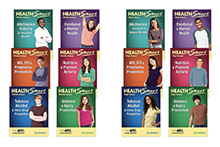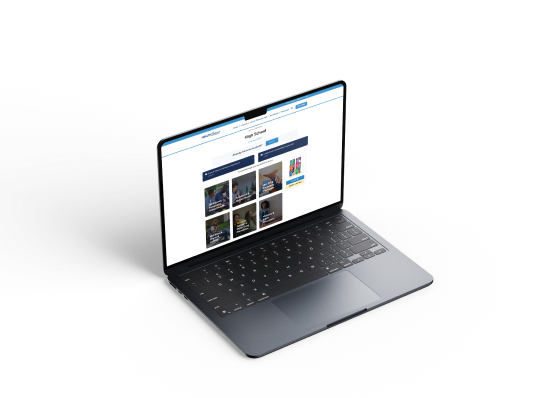Building Health Skills: Goal Setting
By Suzanne Schrag
HealthSmart Series Editor
"This year, I’m finally going to…eat better…meditate daily…get fit…stop smoking…”
The New Year is often a time for making plans and setting goals—often ones that are health related. But moving those aspirations from wishful thinking into action steps isn’t always easy, and it definitely takes skill.
In fact, goal setting is one of the essential skills for health literacy defined in the National Health Education Standards (NHES), which means it’s also a skill focus in the HealthSmart program. HealthSmart envisions and seeks to create a generation of young people who will find it second nature to apply knowledge and skills to achieve healthy New Year’s resolutions and other health goals, all year long.
More and more, a focus on practicing skills is becoming accepted as the best way to help young people establish healthy behaviors and reduce their health risks. In addition to outlining performance indicators for comprehending concepts—the knowledge part of the equation—the NHES also address seven critical health skills. The CDC’s Health Education Curriculum Analysis Tool (HECAT) builds on the National Standards to outline both knowledge and skills expectations for students in Grades K through 12.
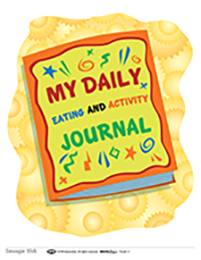 Goal Setting Across the Grades
Goal Setting Across the Grades
As students grow in knowledge, capacity and independence, what it means to practice a particular health skill also evolves. The types of goals, how goals are framed, and the goal-setting process change as students grow and mature. The health habits they seek to establish or maintain can become more sophisticated and complex.
What does it mean to set a goal in kindergarten versus middle school or high school? The Standards offer guidance through the performance indicators outlined for this skill at each grade span.
Kindergarten–Grade 5
In the early elementary grades (Kindergarten–grade 2), there are only two NHES performance indicators for the skill of goal setting: (1) identify a short-term personal health goal and take action toward achieving the goal, and (2) identify who can help when assistance is needed to achieve a personal health goal. For these youngest students, setting a goal means choosing something they can do to help themselves stay healthy, and taking some steps toward that behavior with the help of trusted adults.
At the upper elementary grades (grades 3–5) the performance indicators are similar, but a bit more complex. Students are asked to track their progress toward the personal health goal they set and identify additional resources that can help them achieve it.
Middle School
In Middle School (grades 6 – 8), the Standards start to outline a more formal goal-setting process. This begins with students (1) assessing personal health practices to help them (2) develop a goal to adopt, maintain or improve a personal health practice. They must then (3) apply strategies and skills to achieve a personal health goal, with the added sophistication of being able to (4) describe how personal health goals can vary with changing abilities, priorities and responsibilities. In other words, how do you adapt your goal over time in response to changing circumstances?
High School
High School (grades 9–12) performance indicators ask students to (1) assess personal health practices and overall health status, (2) address strengths, needs and risks in their goal plan, (3) monitor their progress as they implement strategies, and (4) formulate an effective long-term personal health plan. By the time they graduate, students should be able to use their goal-setting skills to help them achieve long-term positive health outcomes.
Some HealthSmart Examples
Goal setting makes particular sense in certain content areas, such as Nutrition and Physical Activity. In fact, in HealthSmart, this content area features goal setting across all of the grade-level spans, growing in complexity and detail as students mature.
Kindergarten-Grade 5
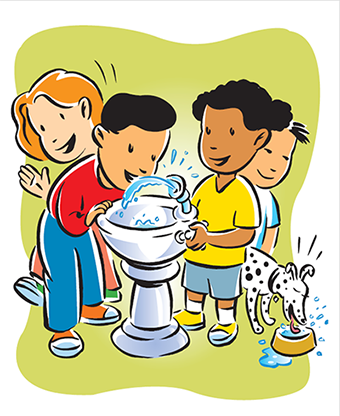
In Grade 1, lessons focus on the importance of drinking water and eating a healthy breakfast. Students then have the option to choose the goal they would prefer to set, based on these lessons: drinking plenty of water or eating breakfast daily.
Grade 2 follows lessons on healthy snacking and the importance of physical activity with goal setting activities around eating 5 fruits and vegetables and being active for 60 minutes each day.
At these early elementary grades, the goal-setting process is quite simple:
- What is my goal?
- What will I do?
- Who can help?
In addition to goals around healthy eating and physical activity, students apply this simple series of steps as they practice making pledges and setting goals around personal health and wellness, such as brushing teeth and washing hands (Grade K), getting enough sleep (Grade 1), and being safety smart (Grade 2).
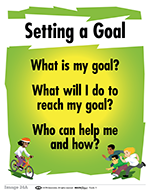 Grades 3 through 5 deepen the goal-setting process, with a more detailed series of steps:
Grades 3 through 5 deepen the goal-setting process, with a more detailed series of steps:
- What is my goal?
- What will I do to reach my goal?
- Who can help me and how?
- What is my reward for reaching my goal?
Lessons at this grade span include some assessment of current behaviors to assist in choosing a goal, and offer worksheets and other processes for tracking progress. Again, goal setting around healthy eating and physical activity is featured at all upper elementary grades, and students also practice setting goals around safety and personal health habits.
Middle and High School
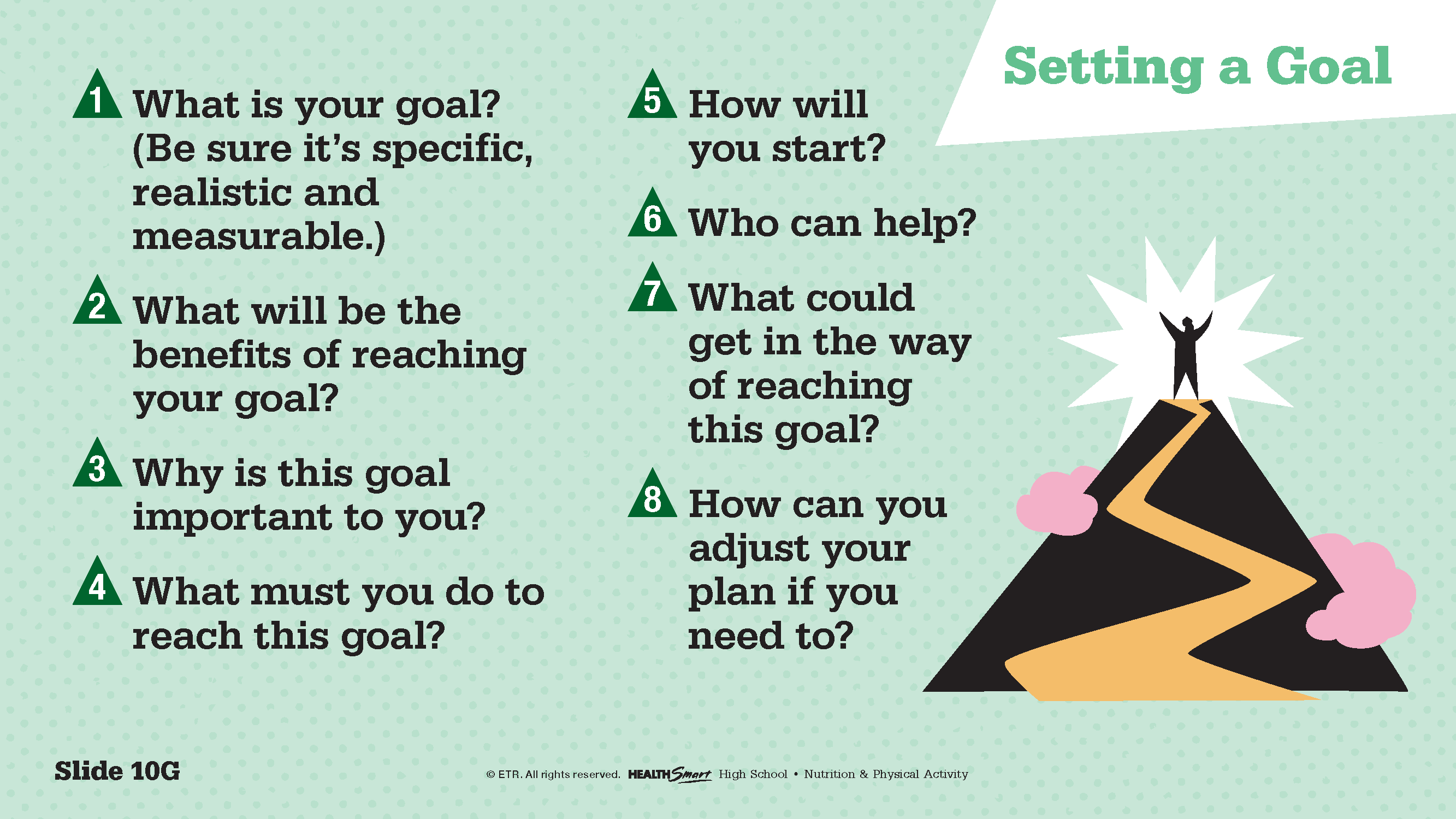 By Middle School, the goal-setting process has become more formalized, mirroring the performance indicators in the Standards:
By Middle School, the goal-setting process has become more formalized, mirroring the performance indicators in the Standards:
- What is your goal?
- What will be the benefits of reaching your goal?
- Why is this goal important to you?
- What must you do to reach the goal?
- How will you start?
- Who can help?
- What could get in the way?
- How can you adjust your plan if you need to?
Students learn the importance of setting specific, realistic and measurable goals. They build motivation and commitment by considering why the goal is important to them and anticipating the benefits of achieving the goal.
In addition, the goal setting activity in the Nutrition & Physical Activity unit is extended over several weeks. Students have opportunities to track their progress, analyze barriers and apply strategies to overcome them, and adapt their goal plan if needed. High School lessons use this same 8-step process, but add even more assessment of current health behaviors and choices in a variety of topic areas, and require students to evaluate their progress, suggesting adjustments to the goal or the action plan as needed.
